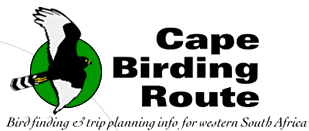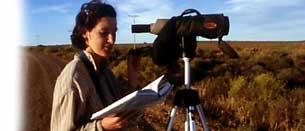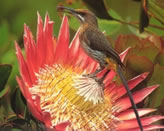|
|
| Select
Specials: Garden Route and Interior
Narina Trogon
Named
after the Khoikhoi mistress of the 18th-century French explorer
and ornithologist François le Vaillant, the Narina
Trogon has a quite unfounded reputation for elusiveness. The
reality is that this bird is not particularly shy, and is
easily deceived by imitations of its call. Note, however,
that trogons invari-ably sound much further away than they
are — you may find yourself patiently trying to lure
in a seemingly distant bird that is in fact only two trees
away from you. They swoop in quietly to perch in the canopy,
usually facing away from you, thus turning a cryptic green
against the forest canopy. Look out for the beautiful patches
of electric blue skin on their faces that puff out as they
call.
Knysna Lourie
This
charismatic endemic makes a worthy icon of the Garden Route.
It is usually first observed as a flash of red gliding through
the green foliage, and is easy to locate by its hoarse, repetitive
and very loud call, rising to a crescendo — one of the
most evocative sounds of the mist-wreathed canopy of South
Africa’s afromontane forests. The Knysna Lourie is perhaps
less shy than other forest louries and appears insatiably
curious. Many a lunch stop will be enlivened by the discovery
of a lourie peering at you through the overhead leaves.
Chorister Robin
The
Afrikaans name for this species, ‘Lawaaimaker’,
is rather less generous than the English! It means ‘racket-maker’,
but however melodious one considers it, the Chorister Robin
is a very fine-looking endemic. In the Western Cape, its range
only extends eastwards from Mossel Bay, and it occurs in all
the Garden Route forests described here. It is perhaps typical
of many forest species in that it is brightly coloured and
vocal, but often infuriatingly skulking. It calls mostly at
dawn, often from the forest canopy, which may make it difficult
to locate. Beware of its remarkable powers of mimicry, which
may be to blame if you are baffled by Crowned Eagles or African
Goshawks calling from dense forest understorey!
African Rock Pipit
This
poorly-known endemic is characteristic of South Africa’s
mountainous interior. It is localized and largely inaccessible
in the region covered by this book, with the notable exception
of the Karoo National Park (opposite); see also Bergenaars
Pass (p.112). African Rock Pipit is curiously inconspicuous
and best detected by call — a rather unpipit-like descending
whistle. The yellow edging on the bird’s folded wing,
rather optimistically exaggerated in some field guides, is
not a good field character. Rather, concentrate on its very
distinctive call, plain plumage and relatively conspicuous
eye-stripe to distinguish it from the Long-billed Pipit, which
favours similarly rocky landscapes.
|
This website is maintained by Birding Africa.
Please do not use any text, images or content from this site without
permission.
© Birding Africa 1997-2009 info@capebirdingroute.org
4 Crassula Way, Pinelands, 7405, Cape Town, South Africa
|

27/09/09: Dalton
Gibbs reports back from Gough
Island! Read the blog!
26/09/09: New Cape
Town Pelagics trip report from trips of 12 and 19 September
2009.
30/08/09: British
Birdwatching Fair at Rutland Water proved very successful,
with sunny weather and over 20,000 visitors. Callan's "Birding
Namibia and the Okavango" was the most highly-attended
lecture on the Saturday, with over 240 people. Congratulations
to the winners of the Birding Africa competition and the
African Bird Club raffle that we helped sponsor!
12/08/09: New Cape
Town Pelagics trip reports from August and July 2009.
Highlights: Little
Shearwater and more!
07/08/09: The
sub-adult Black Sarrowhawk visits our garden again! Read
on about Raptor Research in the Western Cape.
27/07/09: Cape
Town's Verreauxs' Eagle Chick has grown! And its sibling
never had a chance to hatch. See the pictures of the chick,
its nest and the breeding pair. Find out more about the Western
Cape Raptor Research Programme.
27/07/09: To follow modern nomenclature and systematics, we've
adopted the IOC
World Bird List, Version 2.1.
13/07/09: The 8th
African Bird ID Challenge has launched! Win a 50% discount
on a Cape Town Pelagics
trip, a copy of Southern
African Birdfinder, or African
Bird Club membership for 1 year.
6 July 09: Cape
White-eye research in our garden.
2 July 09: Cape
Town's Verreauxs' Eagle Chick has hatched! See the pictures
of the chick, its nest and the breeding pair. Find out more
about the Western Cape Raptor Research Programme.
2 July 09: Campbell
Fleming, a Cape Town scholar, avid birder and photographer,
joined Birding Africa last month as an intern. Click here,
to see what he got up to.
2 July 09: New pelagic
trip reports from the Cape Town Pelagics trips in June
2009. Highlights: Slenderbilled
Prion and Leach's Storm Petrel
30 july 09: Our latest Cape Fynbos and Karoo trip
reports feature Hottentot
Buttonquail, Cinnamon-breasted
Warbler and other fynbos and Karoo endemics...
26 June 09: Tungsten
mining threatens RAMSAR site, South Africa's Verlorenvlei.
Read the Media Release.
22 June 09: Claire
Spottiswoode, one of the Cape Birding Route founders,
was part of the exploratory team at Mount Mabu. The mountain
is part of the newly discovered largest
rainforest in Southern Africa.
11 June 09: A colour-ringed
Black Sparrowhawk visits the Birding Africa office garden.
Read why it's a 10 months old male!
14 June 09:
Wildlife
at the office of The Cape Birding Route, Birding Africa
and Cape Town Pelagics.
31 May 09:
Michel Watelet wins the 7th African Bird Club & Birding Africa
ID Challenge. Test your African birding skills and WIN
a Birding
Africa Cape town day trip or a copy of the Birdfinder!
30 May 09:
A tragedy unfolds at Kommetjie south of Cape town as 44 beached
False
Killer Whales were shot. Click here for more details and
pictures.
14 March 09: Raptor
Watch in Cape Town on 14 March 09
|
|


